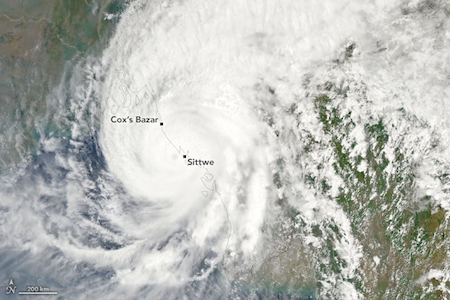Bay of Bengal: Deadly Cyclone Hits Myanmar and Bangladesh
A powerful cyclone named “Mocha” has hit the coastlines of Bangladesh and Myanmar after intensifying into the equivalent of a category-five storm.
Published 2 years ago
Catastrophic Cyclone Mocha (pronounced “Mokha”) made landfall in Myanmar on Sunday, May 14, about 10 miles northwest of the regional capital of Sittwe. The storm crashed through houses and cut power lines in Rakhine state. Myanmar’s meteorological department said it pounded through the country at about 209km/h (130 mph).
Eight hours prior to landfall the Joint Typhoon Warning Center (JTWC) rated Mocha a Category 5 storm with 175 mph winds. This ties Mocha with Cyclone Fani of May 2019 as the strongest tropical cyclone ever recorded in the North Indian Ocean.
The India Meteorological Department (IMD), the official agency responsible for issuing tropical cyclone forecasts in the Indian Ocean, rated Mocha an “extremely severe cyclonic storm” with peak winds of 130 mph (three-minute average) and a central pressure of 938 mb.
This is equivalent to a category 4 hurricane.


According to IMD, Mocha achieved a slightly higher intensity at 21 UTC May 13, with 140 mph winds (3-minute average) and a central pressure of 931 m.
Cooler waters, interaction with land, dry air, and higher wind shear, caused Mocha to weaken notably several hours before landfall and the JTWC rated it a category 4 storm with 155 mph winds at 6 UTC May 14, two hours before landfall.
This makes Mocha tied as the second-strongest cyclone at landfall in the North Indian Ocean in the JTWC database. The only stronger landfalling storm in their records—and the only Cat 5 landfall—was the 1999 Odisha Cyclone of October 1999, whose catastrophic hit on India killed 9,843 people.
News reports suggest the storm caused widespread damage in Sittwe, the state capital of Rakhine, with local news sources reporting flooded streets, downed trees and power lines, and roofs torn from homes.
The evacuation of hundreds of thousands of people from vulnerable areas in both Bangladesh and Myanmar in advance of the storm may have helped limit casualties, according to some news reports. The worst of the storm surge also missed low-lying refugee camps in Cox’s Bazar that many observers feared were vulnerable.
…………………………
Related News:
- Deadly Storm Hits Myanmar and Bangladesh Coast (BBC)
- North Indian Ocean’s Strongest Storm on Record Hits Myanmar (Yale Climate Connections)
- Cyclone Mocha Strikes Myanmar (NASA Earth Observatory)
…………………………
Related Links:
………………………………
Find out all news, reports, links and comments posted on Noonsite, plus cruising information from around the world, by subscribing to our FREE monthly newsletter. Go to https://www.noonsite.com/newsletter/.
Related to following destinations: Kawthaung (formally Victoria Point), Mergui Archipelago, Myanmar (Burma), Yangon (formally Rangoon)
Related to the following Cruising Resources: Hurricanes and Tropical Cyclones, Indian Ocean, Routing, Weather






